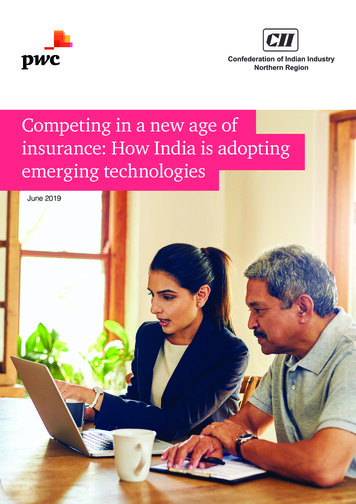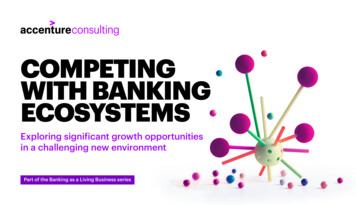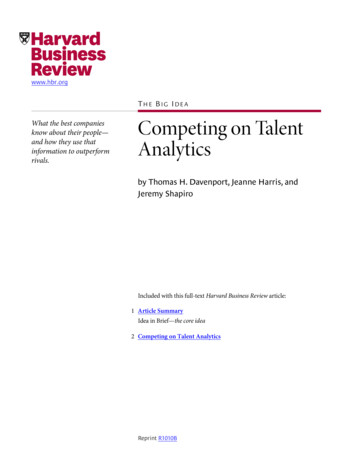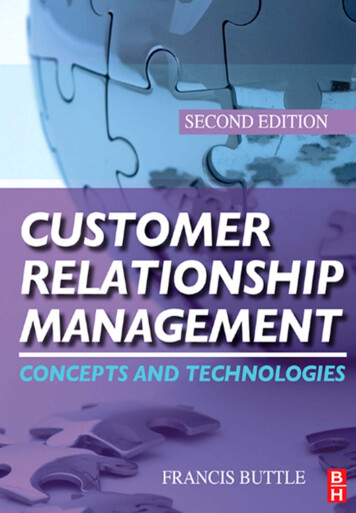
Transcription
Competing in a new age ofinsurance: How India is adoptingemerging technologiesJune 2019
Messages from PwCJoydeep K RoyPartner and Leader, Insurance and Allied BusinessesAs the major global insurance players are busypreparing to enter yet another prosperous market inAsia—Myanmar—it is useful to look back at the last twodecades of the opening up of the market in India. Thefocus has shifted from a mixture of anticipation andtrepidation of operating in a vast and diverse country toa more studied approach in consolidation and focus onprofitability.The last two decades have been interesting for theIndian insurance industry; they may be divided intothree distinct phases. From 2000–2008, there were babysteps, experimentation, seizing of opportunities andexpansion. The next phase, 2008–2014, witnessed theglobal financial meltdown and represented a period ofuncertainty, indecision and a sharp increase in regulatoryscrutiny; accordingly, companies began relooking attheir strategy and expansion. Following the reforms tothe Insurance Act and stabilisation of the economy, thecurrent phase from 2014 onwards has seen renewedconfidence in growth, and certain sectors like healthand agriculture have moved forward aggressively. Also,the digital revolution has pushed insurers to automateand seek out opportunities to digitise every part of theorganisation. Listing of insurance companies on the stockexchange has opened up their black boxes to analysts,thereby introducing further competition in the race fordigitising customer interfaces.Insurance plays a fundamental role in the economy of acountry. It protects the future earnings of individuals andcompanies, enables risk transfer and smooths out therisk patterns, thereby protecting the GDP of a country.Therefore, measuring the premiums as a percentageof GDP and determining the level of penetration is notappropriate as the premiums are fees to protect the GDP.Rather, an appropriate measure would be to see whatproportion of the GDP the sums assured cover. That way,in the fullness of time, adequate penetration should bemeasured by the following:1. The total life insurance sums assured should bearound 5–10 times of the total incomes produced.2. The total assets and liabilities generated by theeconomy should be covered up to approximately80–90%.3. The density of insurance should be taken intoconsideration as to the average percentage ofpeople above the poverty line who are covered.4. Finally, the percentage of population coveredby government and social schemes should beconsidered.The conglomeration of the above numbers will providean accurate assessment of insurance penetration.While India will still feature among the low penetrationeconomies, some surprises may be in store.Finally, merely adopting technology and automatingprocesses will not eliminate inefficiencies. Newtechnology gives rise to new capabilities and processesshould be redesigned accordingly to reduce wastageand delight customers. A change in approach is neededwhereby technology is viewed as a fundamental businesstool rather than an operational and process tool. Thenatural inhibition in a regulated industry can be dispensedwith if organisations work with all stakeholders, includingregulators and the government. The healthy interestregulators are showing in sandboxes bodes well for theindustry.2 PwC Competing in a new age of insurance: How India is adopting emerging technologies
Abhijit MajumdarPartner and Technology Strategy LeaderThe modern insurance customer prefers simple,customised and intuitive policies, an easy process anda simple and tangible cost breakup. Insurance providershave begun to appreciate these preferences and haveput the customer at the centre of product design,eliminating all poor experiences along the ‘moments oftruth’ in his/her insurance adoption journey. This shift inproduct design from product to human-centric design is afundamental shift in the Indian insurance industry.The transformation into a human-centric insurancecompany and product is time-consuming andcomplicated. Design thinking trains organisations to focuson minimising customer effort to maximise customervalue. PwC’s BXT approach helps create human-centric,design-thinking based solutions as it encompasses thepower of perspective.While technology cannot replace the human-centricapproach, it is a key enabler for this approach. Emergingtechnologies like artificial intelligence, the Internet ofthings, and blockchain powered by analytics and thecloud can enable insurers to develop human-centricpropositions. Some of the large insurers have a legacyIT landscape that is difficult and costly to transform.However, the good news is that most Indian insurers havenewer and flexible IT landscapes that are well positionedto adopting these emerging technologies to enablehuman-centric propositions.3 PwC Competing in a new age of insurance: How India is adopting emerging technologies
Contents1. Indian insurance ecosystem1.1 Changing face of the Indian insurance industry1.2 Emerging trends in the Indian insurance industry1.3 Comparison with the global landscape2. PwC India’s Insurance Technology Adoption Survey 20192.1 Technology adoption in the Indian insurance ecosystem2.2 CXOs’ experiences2.3 PwC’s perspective on technology adoption3. Road ahead4 PwC Competing in a new age of insurance: How India is adopting emerging technologies060608091010171928
ExecutivesummaryWith written gross premiums of USD 94.48 billion in FY18, theIndian insurance industry is the fifteenth largest in the worldin terms of premium volume.1 Owing to rising awareness,innovative products and a proliferation of distributionchannels, the insurance industry in India is expected to reachnewer heights by 2020.2 Though insurance reach is still lowin the country and there exists a huge untapped market,government policies of financial inclusion are graduallyhelping to insure the uninsured.PwC’s Digital IQ Survey revealed that innovation in Indiancompanies is driven more by industry and competitionand less by customer insights. Ideally, customer insightsshould be the primary factor behind constant innovation inthe industry.3 The current situation is likely to complicatecustomer satisfaction efforts as there is a risk of competitionbeing the driver instead of the needs of customers. As aresult, a business may have no differentiated offerings orthese may be delayed. In the worst case scenario, the effortsmay not be solving any of the customer’s issues.To understand and explore how the ecosystem of customersin the insurance industry is evolving, in 2019, PwC conducteda survey and discussion with around 200 respondents(including customers, agents and insurers). Further, wegathered the perspectives of all stakeholders on how theindustry is working towards meeting customer expectationsand how emerging technologies can help in bridging the gap.Across industries, the focus is shifting from a product-drivenapproach to customer-driven strategies, and the insuranceindustry is no exception. With technology advancements andtheir growing adoption, every user segment is now becomingmore aware and demanding and they are benchmarkingservice delivery not only against other segments of thefinancial services industry but also across other industriessuch as retail, travel and entertainment.Technology exposure in India is leading to the rise of digitalnatives whose communication, decisions and actions areembedded in technology; Gen X, Y and Z are inherentlyimpatient and information and choices are freely available.The insurance sector cannot ignore this growing customersegment when developing its strategy and roadmap. Further,transaction security, technology compatibility, data privacyand 24x7 availability are now merely hygiene factors fortoday’s customers.While use of technology continues to expand, businessesthat cater to a large number of digital natives need to startadapting their approach in order to understand and deliveraccording to customer expectations.1. IBEF. (September 2018). Indian Insurance Industry Analysis.Retrieved from -20182. Ibid.3. PwC. (2016). 8th Digital IQ Survey: The Indian Story. Retrievedfrom thdigital-iq-survey-the-india-story.pdf5 PwC Competing in a new age of insurance: How India is adopting emerging technologies
1Indianinsurance ecosystemThe insurance industry in India is going through afundamental shift. Rising awareness, accessibility,affordability, regulatory reforms and economic growth aresome of the key factors impacting the industry. For someinsurers, it is a phase of re-establishment and keepingthemselves relevant. For others, dealing with thesedisruptors is critical to their survival. The government’sdecision to permit 49% foreign direct investment hasmade the Indian insurance sector lucrative to foreigninvestors and enabled insurers to secure capital to workon aggressive plans related to expansion and innovation.Further, insurers who have been in business for at least10 years are allowed to raise capital through initial publicofferings (IPOs).Insurers are also investing in the digitisation of businessprocesses to achieve efficiency and cost reduction. Asper an industry estimate, digitisation can reduce around20–30% of the cost of non-life insurance products and15–20% of the cost of life insurance. Apart from the costbenefit, digital transformation also creates opportunitiesfor synergies between them. In future, lack of synergywith customers will affect the market share of insurers.It is one of the compelling reasons for insurers to rethinktheir strategy and focus on customer-oriented initiatives.“Two key areas which need to beaddressed for improving the conversionrate from digital modes are – awarenessneeds to go up and products needto be simplified. The way insurershave designed it with a focus ondifferentiating their USPs, it becomes acomplex product which is difficult forthe customer to understand and buy incouple of clicks.”1.1 Changing face of the Indian insuranceindustry1.1.1 Rise of digital: A game changerThe digital revolution in India has disrupted the businessenvironment in all industries and the insurance industryis no exception. Increasing Internet penetration (with thenumber of users in India expected to rise from 429 millionin 2017 to 829 million by 2021 at the rate of 17.9%)4 willcontinue to influence the insurance business as well asother industries.Given that digital technology has the potential to breakthe traditional barriers of the insurance sector like productawareness level, limited customer touchpoints, accessto knowledge, service availability and payments, thebusiness environment is bound to become more dynamicand competitive. Insurers are now compelled to ensuretheir pricing is competitive and is able to show valuefor money in order to remain significant. By maintainingtransparency in product features, cost and services,digital channels are levelling the playing field.Vishwanath Mahendra, Chief Actuaryand Chief Risk Officer, ApolloMunich Health Insurance Co LtdSource: PwC India’s Insurance Technology Adoption Survey4. IBEF. (January 2018). E-commerce report. Retrieved from -2018.pdf6 PwC Competing in a new age of insurance: How India is adopting emerging technologies
1.1.2 Customer archetypes1.1.3 Evolving value chain: Role of web aggregatorsCustomers have evolved significantly and look for themost transparent and seamless experience. Paper-basedtransactions and long forms are a thing of the past, andconsumers now rely on smartphones for information/feedback, so insurance companies need to embrace thedigital revolution or risk becoming obsolete.Web aggregators have emerged as a new distributionchannel in the insurance value chain. After a regulationon web aggregators was passed in 2013, the countof registered web aggregators increased from 11 in2013 to 21 in March 2017.5 They are now functioning asplatforms for insurance products from multiple insurersand providing information about product features,benefits, price, claim settlement ratio and coverage,etc., along with a comparison of insurance products.Although such facilities are helping customers to evaluatemultiple products on a single platform and reduce theoverall research time, there is a risk of commoditisationof insurance as these comparisons mainly revolvearound price rather than the benefits and suitability ofthe products. While this scenario is expected to improvedue to competition among web aggregators, the ultimatedecision will be in the hands of the customer.As per our survey findings, customers can be classifiedinto three different buckets based on their buyingbehaviour (e.g. level of involvement in purchasedecisions), attitude (e.g. towards a new experience) andexpectations (e.g. in the form of services and supportreceived).As customers have evolved, age-old marketing andcommunication strategies are not going to help withcustomer acquisition and retention. Customers needinteraction points instead of just one-way communicationchannels.Customer archetypesTraditionalists Conventional approach Prefer human touch Apprehensive about digital modes Trust is more crucial in driving loyalty than cost Attracted towards highly responsive insurers whoput customer’s interest on priorityTransitionalists1.1.4 Changing business modelThe conventional insurance model used to be productcentric and marketing-channel driven, while the modernmodel will keep the customer at the core along witha suite of digital technologies and ecosystems to tapthe customer base. Incumbents needs to embrace thechanging business models or they risk losing a majorchunk of pie to new participants. Though unimaginabletoday, a ‘wallet vs. banks’ type of battle could break outin the insurance sector too. A common topic of debateis whether existing distribution channels will be relevantin the digital world or become redundant. Technology israpidly enabling all parties involved in the value chain tobecome more productive and thus improve their returnson effort. Rational customers whose decisionsare largely based upon ‘value for money’ Price conscious Prefer human advice but don’t mind moving tocomputer-only advice Ready to change channels of purchaseDigital natives Have recently entered the workingpopulation in urban areas Technologically advanced Demand flexibility Highly receptive to innovative models Not comfortable with complex T&Cs and benefitstructures5. IRDAI. (2017). Annual report 2016-17. Retrieved from https://www.irdai.gov.in/ADMINCMS/cms/frmGeneral Layout.aspx?page PageNo3360&flag 17 PwC Competing in a new age of insurance: How India is adopting emerging technologies
Insurance at the centre of a new ecosystemTesylteplSource: PwC researchBuy/a d s e llvic eCarDr side e l esdR oa ancCa s sistrR e p ai sweivrerepyin ma rdilitrt atcobEnergysavingHousehitem oldsse HocHomdiInsuranceentadviceannin a n dgri pLifOffering non-insurance services which are a naturalextension of the core product, like financial planning andhealth monitoring, can be the best way for insurers togain the attention of consumers and become key playersin ecosystems of interconnected services. Ecosystemservices can not only build loyalty but also increaseprofits. Also, access to a rich stream of customer datafrom these services can help in honing offerings as wellas delivery efficiency. Many insurers can be expected totry and expand their contribution in the ecosystem.tecrelEnTravtF li g h n gb o o kierC a re n gipla n nteii. Shifting product needsDeclining relevance of traditional products withdecreasing number of customer touchpoints andincreasing requirements to innovate insuranceproduct offerings to meet changing customerbehaviour and needs.Investmadvi entecivdcealFelpla inay/some luHAnsBosrtmanag etconeemm rityeunPernsoloanenloaalWhile some industries seem to be making quantumleaps in technology, digital and online are not always theanswer when it comes to customer expectations. Today’stask-rich and time-poor consumers expect more thanjust 24-hour access, competitive prices and good qualityproducts. In an era where consumers across marketsexpect personalised high-touch service, insurance, byits very nature, remains a low-touch industry. Thus, theproblem of ‘lack of touch’ lies at the heart of insuranceas high-quality interactions are known to be directlycorrelated with loyalty.etmenlthtire geaRe lanninWpialnc ingpernSuToday’s customers have set new standards ofconvenience, ease of use and value. For a long time,the traditional insurance business model proved to beresilient. But now, it’s also beginning to be impacted bydigital.Digital connectedness is blurring industry boundaries,creating opportunities to extend across ecosystems. Anecosystem-based approach involves offering a holisticset of interconnected products/services related to a givendimension of someone’s life, e.g. home, wealth, mobilityor lifestyle.aCustomers’ expectations are getting set outsideof insurance by digital native companies thatoffer convenience and simplicity, leaving thesecustomers frustrated that their insuranceexperience doesn’t match their lifestyle and needs.Businesses that once seemed disconnected are nowfitting together seamlessly and unleashing surprisingsynergies. The changing forces allow every sectorto redraw its borders with wider product and serviceofferings and customer ownership as the ultimate prize.loi. Increasing customer expectationsEven as insurers face competition from up/downstream players, opportunities are arisingfor them to reinvent customer relationships byproviding an ecosystem of services beyondtraditional products.nivs o in gns S ec o n darca h a n dorr matsrk etThrough discussions with stakeholders involved in thevalue chain, we have noted four key trends which aredisrupting and reshaping the insurance competitivelandscape. All of the industry trends are slowlyconverging and ultimately pushing a sector that is slowto adapt by challenging traditional business processes,products and assumptions. To rise to the competitiveforefront, insurers are rethinking and realigning theirbusiness models as per customer needs and theexpectations of future target groups who are likely tobecome their customers in the next 10–20 years.iii. Blurred industry boundariesHom1.2 Emerging trends in the Indian insuranceindustryMFinanceServiceAdviceiv. Rise of FinTech/InsurTechIncumbents need to understand how they canleverage InsurTechs as enablers and partners toenhance the customer offerings, increase theircustomer base and drive operational efficiencies.From the Industrial Age to the Information Age and thepresent Digital Age, technological innovation has beenthe backbone of progress while complemented bycompetition and other key factors that influence newbusiness and economic trends. InsurTech/FinTech aresources of competitive advantage to:8 PwC Competing in a new age of insurance: How India is adopting emerging technologies
Deliver better customer experience by: Meeting changing customer needs with newproduct offerings, e.g. on-demand insurance Enhancing customer interactions, e.g. onlineaggregation and comparison Meeting changing customer expectations, e.g.behaviour-based and personalised offers Leverage data and analytics to generate deeper riskinsights by: Generating deeper risk insights, e.g. telematics,connected car/health/home Utilising new approaches to underwrite riskand predict loss, e.g. fraud algorithm to enableautomated claim assessment and decision Enable business with simplified and efficientprocesses by: Improving core insurance process efficiencythrough robotics and automation Enabling ‘touchless’ processes through artificialintelligence and machine learning Enabling more efficient distribution effort throughB2B and B2C platformsInsurance penetration in India(premiums as % of LifeNon-lifeInsurance density indicates the coverage of thepopulation of a country and is calculated as theratio of total insurance premium paid in a year tothe population of the country. Insurance density hasshown steady growth in the past and has improvedfrom USD 11.5 in 2001 to USD 73 in 2017, but it stilllags behind the global (USD 650) and Asian figures(USD 360).7Insurance density1.3 Comparison with the global landscapeThe Indian insurance sector is underperformingcompared to that of developed and emerging economies.Insurance penetration and density, which are the keyperformance indicators of the insurance industry, areespecially low in India. Further, there is a significant gapbetween insurance coverage and value, which highlightsthe high risk state of country. Since these vital parametersare improving at a stagnant growth rate, there is a longway to go.Insurance penetration, which is measured as the ratioof insurance premium paid and GDP of the country, hasincreased from 2.71% in 2001 to 3.69% in 2017 in India.6Although this is significant development consideringthe volume of business, it lags behind the penetrationlevels in the rest of the world (6.13%) and emerging Asianeconomies onomiesUSD 650GlobalInsurance density in India(premium per capita in surance penetration3.69%IndiaUSD 360USD 73IndiaNon-life6.13%Global6. Swiss Re Institute. (July 21018). Sigma 03/2018: World insurance in 2017: solid, but mature life markets weigh on growth. Retrieved ma-research/sigma-2018-03.htmlIRDAI. (2017). Annual report 2016-17. Retrieved from https://www.irdai.gov.in/ADMINCMS/cms/frmGeneral Layout.aspx?page PageNo3360&flag 17. Ibid.9 PwC Competing in a new age of insurance: How India is adopting emerging technologies
2PwC India’s Insurance TechnologyAdoption Survey 2019Our survey of customers, agents and insurers exploredhow the entire insurance customer ecosystem in Indiais changing as a result of emerging trends and evolvingcustomer needs and expectations.2.1 Technology adoption in the Indianinsurance ecosystemOur discussion with customers revealed eight significantinsights.2.1.1 Preferred purchase mode for insuranceIn the Indian landscape, insurance is still a push businessand is considered as a complex product for whichcustomers rely on face-to-face interaction for betterunderstanding of the product’s features and pricing. Thisis apparent from the survey responses, where around55% of customers still prefer to buy insurance productsfrom agents/brokers and the conversion rate from theonline mode is just around 4%.Further analysis was conducted to identify thedimensions that influence customers to engage with aparticular mode. On an average, convenience appearsto be the primary reason, with 41% of the respondentschoosing a particular mode of insurance purchase basedon it. Direct approach by an agent comes next with 20%of the respondents selecting it.Preferred mode of insurance purchase and reasons for it40%44%3% %21%31%ConvenienceWord of mouthOffers/schemes, priceDirect approach from any agentOthers (policy renewal, productknown, trust)From agentInsurance company staffFrom online aggregatorsFrom insurance company's websiteFrom my own organisationAny other online mode10 PwC Competing in a new age of insurance: How India is adopting emerging technologies25%10%
2.1.2 Preferred source of valuable information to planfor purchaseIn general, feedback matters a lot with respect to not justgetting recurring business but also converting prospectsinto customers. The survey also revealed that word ofmouth is a significant channel (27% of the respondents)for spreading information crucial to purchase planning.Digital modes (47%) are the most preferred and reliablechannels leveraged to seek authentic information andverify the information received from other sources,including family, friends or agents. Also, onlineaggregators (20%) are becoming an integral part of thevalue chain and their preference score is almost on parwith that of company websites as a valuable source ofinformation.Digital modeMost valuable source of informationCompany website18%Online aggregatorFinancial 7%Others3%0% 5% 10% 15% 20% 25% 30%11 PwC Competing in a new age of insurance: How India is adopting emerging technologies
2.1.3 Communication channel for existing insuranceCustomers still consider agents (32%) as the preferredmedium for any kind of communication on their existingpolicy, even after the purchase of insurance; the nextpreferred channel is the company website (20%). Thisindicates the importance of human touch in the Indianinsurance ecosystem even in the digital era. Althoughaggregators are becoming an integral part of the entirevalue chain, their role is minimal once the customergraduates to the next phase of insurance servicing.Emerging technology (such as chatbots) has alreadystarted picking up as the customer’s first point of contact.It has the potential to expand to multiple phases ofcustomer engagement.Though smartphone adoption in India has grown at a rateof 19.43% during the period 2015–18 and is expectedto grow by 7.80% by 2022,8 in the case of insurance,the adoption of apps is still at a nascent stage. This canbe attributed to limited awareness and lack of simpleversions.Most preferable and primary channel49%Digital mode32%Meet/call an agent18%Emails1%Letters9%Any third party (including aggregators)20%Insurance company’s website/portal13%Online chat on insurance company’s website3%Insurance company’s social media page5%Insurance company’s appsDigital mode Third party (including aggregators) website/portal online chat social media page appsSource: PwC India’s Insurance Technology Adoption Survey 20198. Statista. (2019). India mobile phone users 2013-2019. Retrieved from t-of-mobilephone-users-in-india/12 PwC Competing in a new age of insurance: How India is adopting emerging technologies
2.1.4 Customers’ preferred platform for interactionAlthough customers are more open towards digitalmedia, they still expect human interaction for criticalcommunication.The analysis of customer expectations regarding futureinteraction during the customer lifecycle suggests thefollowing key trends: The role of digital is comparatively higher than that ofthe agent/broker during purchase and service. Interestingly, 41% of customers would prefer humaninteraction over the online mode while planning apurchase. Assistant/chatbots are the preferred interactionmedium only during the service period. For product-like insurance, customers still prefer activehuman interaction to understand the nuances of allthe phases, especially at the pre-purchase and claimstages.Customer-preferred platform for interactionFor understanding theinsuranceterms/benefits/limitations/costFor insurancepurchase5%2%25%15%For service-likequeries, complaintsand account detailsmodification, etc.12%39%6%30%28%8%Direct call to agent/customer careEmail to agent/customer care49%42%51%55%For insuranceclaim18%15%Mobile app/web portalVirtual assistance/chatbotsSource: PwC India’s Insurance Technology Adoption Survey 201913 PwC Competing in a new age of insurance: How India is adopting emerging technologies
2.1.5 Digital and social media behaviour of insurancecustomersSocial media adoption is growing across geographies,age groups and mindsets. Customers in general areimpacted by social media on a daily basis and thesechannels can’t be neglected by any businesses today.It is interesting to know how insurance customers areembracing social media and the key uses of social mediawhich are relevant for insurance providers.ii. Limited customer engagement on social media3. Social media penetration in India is quite extensive,with 55% of active Internet users having a socialmedia presence.94. Approximately 17% customers are using socialmedia to stay up to date with the latest trends.Further, 5% actively engages in discussion ontopics of interest on social media, while 70% havenever participated in such discussions.iii. Limited word of mouth on digital platformsi. Opinion matters most while planning to engagewith the insurer1. As per the survey results, around 44% of customersprefer to seek the opinions of others while choosingan insurance product.2. 67% of customers prefer to leverage aggregators/online platforms which enable them to makecalculated and informed decisions by comparingproducts.4. An interesting finding from our survey was that70% of customers have never shared their positiveor negative experiences related to an insuranceproduct. However, one-third of them would like todo so in future.Social media activities of insurance customers40%25%8%38%16%44%67%45%17%Readingonline reviewsComparisonwith otherinsurancecompany'sproductUsing socialmedia to stayup to datewith the latesttrendsI do most of the time25%26%70%68%5%6%Activelyparticipate onsocial mediaon related topicsNever donePostingmy my negativeinsuranceserviceexperienceWould do sometimeSource: PwC India’s Insurance Technology Adoption Survey 20199. Digital population in India as of January 2018 (in millions): igital-population14 PwC Competing in a new age of insurance: How India is adopting emerging technologies
2.1.6 Likelihood of switching to another insuranceprovider based on experience with the insurerThe top three areas which demand the attention ofinsurers are:When asked about the satisfaction level with theirexisting insurance provider, a majority of custom
1.2 Emerging trends in the Indian insurance industry 1.3 Comparison with the global landscape 2. PwC India's Insurance Technology Adoption Survey 2019 2.1 Technology adoption in the Indian insurance ecosystem 2.2 CXOs' experiences 2.3 PwC's perspective on technology adoption 3. Road ahead 06 10 08 17 06 10 09 19 28











